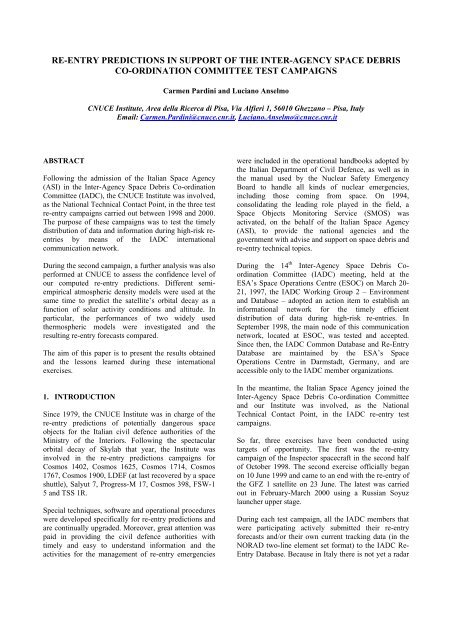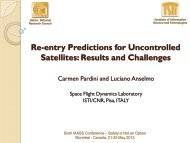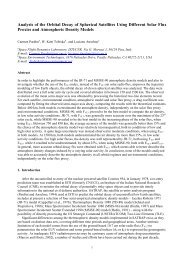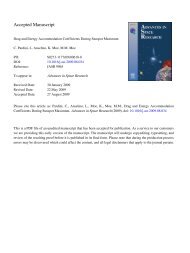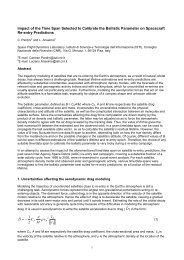Reentry Predictions in Support of the IADC Test Campaigns
Reentry Predictions in Support of the IADC Test Campaigns
Reentry Predictions in Support of the IADC Test Campaigns
Create successful ePaper yourself
Turn your PDF publications into a flip-book with our unique Google optimized e-Paper software.
RE-ENTRY PREDICTIONS IN SUPPORT OF THE INTER-AGENCY SPACE DEBRIS<br />
CO-ORDINATION COMMITTEE TEST CAMPAIGNS<br />
ABSTRACT<br />
Carmen Pard<strong>in</strong>i and Luciano Anselmo<br />
CNUCE Institute, Area della Ricerca di Pisa, Via Alfieri 1, 56010 Ghezzano – Pisa, Italy<br />
Email: Carmen.Pard<strong>in</strong>i@cnuce.cnr.it, Luciano.Anselmo@cnuce.cnr.it<br />
Follow<strong>in</strong>g <strong>the</strong> admission <strong>of</strong> <strong>the</strong> Italian Space Agency<br />
(ASI) <strong>in</strong> <strong>the</strong> Inter-Agency Space Debris Co-ord<strong>in</strong>ation<br />
Committee (<strong>IADC</strong>), <strong>the</strong> CNUCE Institute was <strong>in</strong>volved,<br />
as <strong>the</strong> National Technical Contact Po<strong>in</strong>t, <strong>in</strong> <strong>the</strong> three test<br />
re-entry campaigns carried out between 1998 and 2000.<br />
The purpose <strong>of</strong> <strong>the</strong>se campaigns was to test <strong>the</strong> timely<br />
distribution <strong>of</strong> data and <strong>in</strong>formation dur<strong>in</strong>g high-risk reentries<br />
by means <strong>of</strong> <strong>the</strong> <strong>IADC</strong> <strong>in</strong>ternational<br />
communication network.<br />
Dur<strong>in</strong>g <strong>the</strong> second campaign, a fur<strong>the</strong>r analysis was also<br />
performed at CNUCE to assess <strong>the</strong> confidence level <strong>of</strong><br />
our computed re-entry predictions. Different semiempirical<br />
atmospheric density models were used at <strong>the</strong><br />
same time to predict <strong>the</strong> satellite’s orbital decay as a<br />
function <strong>of</strong> solar activity conditions and altitude. In<br />
particular, <strong>the</strong> performances <strong>of</strong> two widely used<br />
<strong>the</strong>rmospheric models were <strong>in</strong>vestigated and <strong>the</strong><br />
result<strong>in</strong>g re-entry forecasts compared.<br />
The aim <strong>of</strong> this paper is to present <strong>the</strong> results obta<strong>in</strong>ed<br />
and <strong>the</strong> lessons learned dur<strong>in</strong>g <strong>the</strong>se <strong>in</strong>ternational<br />
exercises.<br />
1. INTRODUCTION<br />
S<strong>in</strong>ce 1979, <strong>the</strong> CNUCE Institute was <strong>in</strong> charge <strong>of</strong> <strong>the</strong><br />
re-entry predictions <strong>of</strong> potentially dangerous space<br />
objects for <strong>the</strong> Italian civil defence authorities <strong>of</strong> <strong>the</strong><br />
M<strong>in</strong>istry <strong>of</strong> <strong>the</strong> Interiors. Follow<strong>in</strong>g <strong>the</strong> spectacular<br />
orbital decay <strong>of</strong> Skylab that year, <strong>the</strong> Institute was<br />
<strong>in</strong>volved <strong>in</strong> <strong>the</strong> re-entry predictions campaigns for<br />
Cosmos 1402, Cosmos 1625, Cosmos 1714, Cosmos<br />
1767, Cosmos 1900, LDEF (at last recovered by a space<br />
shuttle), Salyut 7, Progress-M 17, Cosmos 398, FSW-1<br />
5 and TSS 1R.<br />
Special techniques, s<strong>of</strong>tware and operational procedures<br />
were developed specifically for re-entry predictions and<br />
are cont<strong>in</strong>ually upgraded. Moreover, great attention was<br />
paid <strong>in</strong> provid<strong>in</strong>g <strong>the</strong> civil defence authorities with<br />
timely and easy to understand <strong>in</strong>formation and <strong>the</strong><br />
activities for <strong>the</strong> management <strong>of</strong> re-entry emergencies<br />
were <strong>in</strong>cluded <strong>in</strong> <strong>the</strong> operational handbooks adopted by<br />
<strong>the</strong> Italian Department <strong>of</strong> Civil Defence, as well as <strong>in</strong><br />
<strong>the</strong> manual used by <strong>the</strong> Nuclear Safety Emergency<br />
Board to handle all k<strong>in</strong>ds <strong>of</strong> nuclear emergencies,<br />
<strong>in</strong>clud<strong>in</strong>g those com<strong>in</strong>g from space. On 1994,<br />
consolidat<strong>in</strong>g <strong>the</strong> lead<strong>in</strong>g role played <strong>in</strong> <strong>the</strong> field, a<br />
Space Objects Monitor<strong>in</strong>g Service (SMOS) was<br />
activated, on <strong>the</strong> behalf <strong>of</strong> <strong>the</strong> Italian Space Agency<br />
(ASI), to provide <strong>the</strong> national agencies and <strong>the</strong><br />
government with advise and support on space debris and<br />
re-entry technical topics.<br />
Dur<strong>in</strong>g <strong>the</strong> 14 th Inter-Agency Space Debris Coord<strong>in</strong>ation<br />
Committee (<strong>IADC</strong>) meet<strong>in</strong>g, held at <strong>the</strong><br />
ESA’s Space Operations Centre (ESOC) on March 20-<br />
21, 1997, <strong>the</strong> <strong>IADC</strong> Work<strong>in</strong>g Group 2 – Environment<br />
and Database – adopted an action item to establish an<br />
<strong>in</strong>formational network for <strong>the</strong> timely efficient<br />
distribution <strong>of</strong> data dur<strong>in</strong>g high-risk re-entries. In<br />
September 1998, <strong>the</strong> ma<strong>in</strong> node <strong>of</strong> this communication<br />
network, located at ESOC, was tested and accepted.<br />
S<strong>in</strong>ce <strong>the</strong>n, <strong>the</strong> <strong>IADC</strong> Common Database and Re-Entry<br />
Database are ma<strong>in</strong>ta<strong>in</strong>ed by <strong>the</strong> ESA’s Space<br />
Operations Centre <strong>in</strong> Darmstadt, Germany, and are<br />
accessible only to <strong>the</strong> <strong>IADC</strong> member organizations.<br />
In <strong>the</strong> meantime, <strong>the</strong> Italian Space Agency jo<strong>in</strong>ed <strong>the</strong><br />
Inter-Agency Space Debris Co-ord<strong>in</strong>ation Committee<br />
and our Institute was <strong>in</strong>volved, as <strong>the</strong> National<br />
Technical Contact Po<strong>in</strong>t, <strong>in</strong> <strong>the</strong> <strong>IADC</strong> re-entry test<br />
campaigns.<br />
So far, three exercises have been conducted us<strong>in</strong>g<br />
targets <strong>of</strong> opportunity. The first was <strong>the</strong> re-entry<br />
campaign <strong>of</strong> <strong>the</strong> Inspector spacecraft <strong>in</strong> <strong>the</strong> second half<br />
<strong>of</strong> October 1998. The second exercise <strong>of</strong>ficially began<br />
on 10 June 1999 and came to an end with <strong>the</strong> re-entry <strong>of</strong><br />
<strong>the</strong> GFZ 1 satellite on 23 June. The latest was carried<br />
out <strong>in</strong> February-March 2000 us<strong>in</strong>g a Russian Soyuz<br />
launcher upper stage.<br />
Dur<strong>in</strong>g each test campaign, all <strong>the</strong> <strong>IADC</strong> members that<br />
were participat<strong>in</strong>g actively submitted <strong>the</strong>ir re-entry<br />
forecasts and/or <strong>the</strong>ir own current track<strong>in</strong>g data (<strong>in</strong> <strong>the</strong><br />
NORAD two-l<strong>in</strong>e element set format) to <strong>the</strong> <strong>IADC</strong> Re-<br />
Entry Database. Because <strong>in</strong> Italy <strong>the</strong>re is not yet a radar
sensor capable <strong>of</strong> search<strong>in</strong>g for and track<strong>in</strong>g a low<br />
orbit<strong>in</strong>g spacecraft, our Institute contributed to <strong>the</strong><br />
campaigns provid<strong>in</strong>g only its computed re-entry<br />
predictions.<br />
A fur<strong>the</strong>r analysis was also performed at CNUCE<br />
dur<strong>in</strong>g <strong>the</strong> second campaign to verify, and maybe<br />
improve, <strong>the</strong> confidence level <strong>of</strong> our re-entry forecasts.<br />
In particular, <strong>the</strong> dependence <strong>of</strong> <strong>the</strong> re-entry and orbital<br />
decay predictions on <strong>the</strong> air density model used was<br />
<strong>in</strong>vestigated. In order to reduce <strong>the</strong> number <strong>of</strong> variables<br />
<strong>in</strong> <strong>the</strong> classical relation to compute <strong>the</strong> aerodynamic<br />
drag force, <strong>the</strong> GFZ 1 satellite, hav<strong>in</strong>g a spherical shape<br />
and perfectly known physical characteristics, was<br />
selected. Therefore, four different atmospheric density<br />
models (Jacchia-Roberts 1971 (JR-71) [1], Mass<br />
Spectrometer Incoherent Scatter 1986 (MSIS-86) [2],<br />
Mass Spectrometer Incoherent Scatter Extended 1990<br />
(MSISE-90) [3], Thermospheric Density 1988 (TD-88)<br />
[4]) were used at <strong>the</strong> same time to analyze its orbital<br />
decay, from <strong>the</strong> launch to <strong>the</strong> re-entry epoch (19 April<br />
1995 - 23 June 1999). For <strong>the</strong> sake <strong>of</strong> brevity we refer to<br />
[5] for a complete discussion <strong>of</strong> all <strong>the</strong> results obta<strong>in</strong>ed.<br />
The re-entry predictions dur<strong>in</strong>g <strong>the</strong> <strong>IADC</strong> campaign<br />
(10-23 June 1999), us<strong>in</strong>g <strong>the</strong> JR-71 and <strong>the</strong> MSIS-86<br />
models, are <strong>in</strong>stead presented <strong>in</strong> this paper.<br />
2. RE-ENTRY PREDICTIONS<br />
2.1 The Orbital Predictor<br />
On 1994-1995, <strong>the</strong> JPL’s trajectory predictor ASAP [6],<br />
formerly <strong>in</strong>stalled at CNUCE, was extensively modified<br />
and upgraded to provide high accuracy re-entry<br />
predictions. The result<strong>in</strong>g s<strong>of</strong>tware, SATRAP [7],<br />
<strong>in</strong>cluded a broad selection <strong>of</strong> atmospheric density<br />
models (exponential, 1976 US Standard Atmosphere;<br />
JR-71, MSIS-86, MSISE-90, TD-88) and <strong>the</strong> possibility<br />
to directly process, <strong>in</strong> a correct and consistent way [8],<br />
<strong>the</strong> NORAD Two-L<strong>in</strong>e Elements (TLE), which, for<br />
uncontrolled satellite re-entry, are <strong>of</strong>ten <strong>the</strong> only source<br />
<strong>of</strong> orbital <strong>in</strong>formation generally available. SATRAP<br />
uses <strong>the</strong> Cowell’s method to solve <strong>the</strong> equations <strong>of</strong><br />
motion and a s<strong>in</strong>gle step 8 th order Runge-Kutta method<br />
for <strong>the</strong>ir numerical <strong>in</strong>tegration.<br />
SATRAP has been used dur<strong>in</strong>g <strong>the</strong> <strong>IADC</strong> re-entry<br />
campaigns and <strong>the</strong> follow<strong>in</strong>g orbital perturbations were<br />
considered: zonal and tesseral harmonics <strong>of</strong> <strong>the</strong><br />
geopotential up to <strong>the</strong> 16 th degree and order, third body<br />
attraction <strong>of</strong> <strong>the</strong> moon and <strong>the</strong> sun, solar radiation<br />
pressure (with eclipses) and, <strong>of</strong> course, aerodynamic<br />
drag. The atmospheric density was computed accord<strong>in</strong>g<br />
to <strong>the</strong> JR-71 model, dur<strong>in</strong>g <strong>the</strong> <strong>IADC</strong> <strong>in</strong>augural and<br />
latest exercises (Inspector spacecraft and Soyuz<br />
launcher upper stage), and to <strong>the</strong> JR-71 and MSIS-86<br />
models, dur<strong>in</strong>g <strong>the</strong> second campaign (GFZ 1).<br />
2.2 Sources <strong>of</strong> Orbital Data<br />
For each re-entry campaign, a few <strong>IADC</strong> member<br />
organizations, equipped with <strong>the</strong>ir own observational<br />
facilities, submitted current track<strong>in</strong>g data <strong>in</strong> <strong>the</strong> two-l<strong>in</strong>e<br />
element set format. These data were stored <strong>in</strong> <strong>the</strong> <strong>IADC</strong><br />
Re-Entry Database and could be accessed by authorized<br />
<strong>IADC</strong> members. The most frequently issued were <strong>the</strong><br />
TLE provided by NASA. These elements constituted <strong>the</strong><br />
ma<strong>in</strong> source <strong>of</strong> our orbital data.<br />
2.3 Sources <strong>of</strong> Environmental Data<br />
Apart from <strong>the</strong> 1976 US Standard Atmosphere and, <strong>of</strong><br />
course, <strong>the</strong> exponential formulation, <strong>the</strong> SATRAP’s<br />
atmospheric density models need two different<br />
environmental <strong>in</strong>puts: <strong>the</strong> 10.7 cm solar flux (F10.7) and<br />
a planetary geomagnetic <strong>in</strong>dex (Kp or Ap). This<br />
<strong>in</strong>formation is conta<strong>in</strong>ed <strong>in</strong> <strong>the</strong> <strong>IADC</strong> Common<br />
Database, that provides <strong>the</strong> monthly mean <strong>of</strong> <strong>the</strong> F10.7<br />
and Ap <strong>in</strong>dices, from 1957 to 2099, as well as <strong>the</strong>ir dailyobserved<br />
values dur<strong>in</strong>g <strong>the</strong> last three months.<br />
However, a database <strong>in</strong>clud<strong>in</strong>g <strong>in</strong>formation on <strong>the</strong> solar<br />
and geomagnetic activity is also ma<strong>in</strong>ta<strong>in</strong>ed at CNUCE,<br />
<strong>in</strong> support <strong>of</strong> <strong>the</strong> Space Objects Monitor<strong>in</strong>g Service.<br />
Beg<strong>in</strong>n<strong>in</strong>g <strong>in</strong> June 1987, this database conta<strong>in</strong>s <strong>the</strong><br />
observed values <strong>of</strong> <strong>the</strong> 10.7 cm daily solar flux, as well<br />
as <strong>the</strong> daily planetary geomagnetic <strong>in</strong>dex Ap. Both are<br />
obta<strong>in</strong>ed, via mail or Internet, from <strong>the</strong> NOAA National<br />
Geophysical Data Center (NGDC) <strong>in</strong> Boulder,<br />
Colorado. The current and 27-day outlook <strong>in</strong>dices are<br />
<strong>in</strong>stead acquired from <strong>the</strong> NOAA Space Environment<br />
Center (SEC), which provides real-time monitor<strong>in</strong>g and<br />
forecast<strong>in</strong>g <strong>of</strong> solar and geophysical events. Generally,<br />
<strong>the</strong>se are only prelim<strong>in</strong>ary values and are updated as <strong>the</strong><br />
f<strong>in</strong>al ones become available through <strong>the</strong> NGDC. F<strong>in</strong>ally,<br />
<strong>the</strong> predicted solar flux data until 2018 are those<br />
computed by K. H. Schatten and distributed via <strong>the</strong><br />
EnviroNET onl<strong>in</strong>e service <strong>of</strong> <strong>the</strong> NASA Goddard Space<br />
Flight Center (GSFC).<br />
The CNUCE database was used to describe <strong>the</strong> solar<br />
and geomagnetic activity dur<strong>in</strong>g <strong>the</strong> <strong>IADC</strong> test<br />
campaigns. But frequent comparisons with <strong>the</strong> <strong>IADC</strong><br />
Common Database were carried out to verify <strong>the</strong><br />
consistency <strong>of</strong> <strong>the</strong> data.<br />
2.4 Ballistic Parameter Estimation<br />
To improve <strong>the</strong> accuracy <strong>of</strong> <strong>the</strong> re-entry prediction<br />
process, <strong>the</strong> ballistic parameter B <strong>of</strong> a satellite need to<br />
be <strong>in</strong>dependently determ<strong>in</strong>ed and updated. Def<strong>in</strong>ed by<br />
<strong>the</strong> relation
CD<br />
A<br />
B =<br />
2M<br />
where CD is <strong>the</strong> drag coefficient, A <strong>the</strong> effective crosssection<br />
and M <strong>the</strong> mass, <strong>the</strong> ballistic parameter<br />
<strong>in</strong>corporates <strong>the</strong> uncerta<strong>in</strong>ties associated to <strong>the</strong> physical<br />
characteristics <strong>of</strong> <strong>the</strong> satellite, to its attitude and, for a<br />
given atmospheric model, to <strong>the</strong> air density. Therefore,<br />
for each object and atmospheric density model, B must<br />
be adjusted, to reduce <strong>the</strong> impact <strong>of</strong> <strong>the</strong> abovementioned<br />
uncerta<strong>in</strong>ties.<br />
In this study, we assumed A and M to be constant for<br />
each satellite, while adjusted drag coefficients were<br />
obta<strong>in</strong>ed by fitt<strong>in</strong>g with SATRAP <strong>the</strong> observed<br />
evolution <strong>of</strong> <strong>the</strong> mean semi-major axis result<strong>in</strong>g from<br />
<strong>the</strong> historical two-l<strong>in</strong>e elements record.<br />
2.5 Re-entry Condition and W<strong>in</strong>dow<br />
For each satellite, <strong>the</strong> drag coefficient able to reproduce<br />
<strong>the</strong> past observed semi-major axis decay was used <strong>in</strong><br />
SATRAP to propagate <strong>the</strong> last TLE available.<br />
Therefore, <strong>the</strong> satellite was supposed to re-enter <strong>the</strong><br />
atmosphere when it reached an altitude <strong>of</strong> 90 km over<br />
<strong>the</strong> terrestrial reference ellipsoid. Accord<strong>in</strong>g to this reentry<br />
condition, a predicted re-entry time was <strong>the</strong>n<br />
computed.<br />
Never<strong>the</strong>less, as <strong>the</strong> aerodynamic drag force depends on<br />
a variety <strong>of</strong> different parameters, which cannot be<br />
accurately estimated, a re-entry w<strong>in</strong>dow was obta<strong>in</strong>ed<br />
by assum<strong>in</strong>g a variation <strong>of</strong> <strong>the</strong> drag coefficient by plus<br />
or m<strong>in</strong>us 20%.<br />
3. <strong>IADC</strong> RE-ENTRY TEST CAMPAIGNS<br />
The first time <strong>the</strong> <strong>IADC</strong> member organizations had<br />
access to <strong>the</strong> <strong>IADC</strong> Re-Entry Database, through <strong>the</strong>ir<br />
Technical Po<strong>in</strong>ts <strong>of</strong> Contact, was on 15 October 1998,<br />
for <strong>the</strong> first exercise: <strong>the</strong> re-entry <strong>of</strong> <strong>the</strong> German<br />
Inspector spacecraft (1997-058D; NORAD catalog<br />
number: 25100). It was not a risky object, but only a<br />
small spacecraft <strong>of</strong> opportunity. It had a launch mass <strong>of</strong><br />
68.5 kg, a length <strong>of</strong> 90 cm and a hexagonal crosssection,<br />
with diameter between 44.8 cm and 51.7 cm.<br />
Follow<strong>in</strong>g a post-event assessment <strong>of</strong> <strong>the</strong> US Space<br />
Command, <strong>the</strong> re-entry <strong>of</strong> <strong>the</strong> Inspector spacecraft<br />
occurred on 1 November 1998, at 19:49 UTC.<br />
The second <strong>IADC</strong> exercise <strong>of</strong>ficially began on 10 June<br />
1999, to follow <strong>the</strong> re-entry <strong>of</strong> <strong>the</strong> German GFZ 1<br />
satellite (1986-017JE; NORAD catalog number: 23558).<br />
This geodetic research satellite had a spherical shape,<br />
with a diameter <strong>of</strong> 21.5 cm and a mass <strong>of</strong> 20 kg. This<br />
campaign was declared <strong>of</strong>f after <strong>the</strong> German FGAN’s<br />
TIRA radar system did not observe a predicted pass <strong>of</strong><br />
<strong>the</strong> GFZ 1 satellite at, approximately, 02:26 UTC, on 23<br />
June 1999. The last acquisition occurred dur<strong>in</strong>g <strong>the</strong><br />
previous orbit, at 00:56 UTC.<br />
The re-entry <strong>of</strong> a Russian Soyuz launcher upper stage<br />
(1999-058E; NORAD catalog number: 25947) was <strong>the</strong><br />
subject <strong>of</strong> <strong>the</strong> third <strong>IADC</strong> exercise, on 25 February<br />
2000. This object had a cyl<strong>in</strong>drical shape, with a<br />
diameter <strong>of</strong> 2.7 m and a length <strong>of</strong> 8.2 m. Its empty mass<br />
was 2300 kg. Unfortunately, its f<strong>in</strong>al orbital data were<br />
not submitted to <strong>the</strong> <strong>IADC</strong> Re-Entry Database and our<br />
last prediction was based on a TLE about 14 hours older<br />
than <strong>the</strong> predicted re-entry time. The actual re-entry<br />
occurred at 05:50 UTC, on 4 March 2000.<br />
4. RESULTS<br />
For each object, <strong>the</strong> re-entry prediction process <strong>in</strong>volved<br />
<strong>the</strong> follow<strong>in</strong>g steps:<br />
acquisition <strong>of</strong> <strong>the</strong> historical and current TLE<br />
(from <strong>the</strong> Orbital Information Group – OIG –<br />
<strong>of</strong> NASA/GSFC and/or <strong>IADC</strong> Re-Entry<br />
Database);<br />
update <strong>of</strong> <strong>the</strong> CNUCE database <strong>in</strong>clud<strong>in</strong>g solar<br />
and geomagnetic activity data (from SEC <strong>of</strong><br />
NOAA/NGDC and/or <strong>IADC</strong> Common<br />
Database);<br />
selection <strong>of</strong> an atmospheric density model and<br />
calibration <strong>of</strong> <strong>the</strong> drag coefficient by fitt<strong>in</strong>g <strong>the</strong><br />
past observed semi-major axis decay;<br />
propagation <strong>of</strong> <strong>the</strong> last TLE (ma<strong>in</strong>ta<strong>in</strong><strong>in</strong>g<br />
constant <strong>the</strong> previously computed CD) as far as<br />
<strong>the</strong> re-entry condition was satisfied;<br />
determ<strong>in</strong>ation <strong>of</strong> <strong>the</strong> re-entry w<strong>in</strong>dow, by<br />
assum<strong>in</strong>g a drag coefficient variation <strong>of</strong> ± 20%.<br />
4.1 Inspector<br />
Accord<strong>in</strong>g to <strong>the</strong> post-event assessment <strong>of</strong> <strong>the</strong> US Space<br />
Command, <strong>the</strong> actual re-entry time <strong>of</strong> <strong>the</strong> Inspector<br />
spacecraft was 19:49 UTC, on 1 November 1998. Our<br />
re-entry prediction results are summarized <strong>in</strong> Table 1<br />
and <strong>in</strong> Fig. 1. In Table 1, PERL <strong>in</strong>dicates <strong>the</strong> Percentage<br />
Errors on <strong>the</strong> Residual Lifetime (a negative/positive<br />
sign implies that <strong>the</strong> computed re-entry time<br />
preceded/followed <strong>the</strong> actual one), while PN is <strong>the</strong><br />
associated re-entry Prediction Number.<br />
The average drag coefficient found was 1.95, with a<br />
standard deviation <strong>of</strong> 3.9%. The absolute error on <strong>the</strong><br />
residual lifetime was lower than 14%, but dur<strong>in</strong>g <strong>the</strong><br />
campaign <strong>the</strong>re was a systematic trend to anticipate <strong>the</strong><br />
re-entry date. Also a post-event estimation gave a re-
entry time 12 m<strong>in</strong>utes <strong>in</strong> advance with respect to <strong>the</strong><br />
actual one.<br />
PN PERL<br />
%<br />
Table 1<br />
RE-ENTRY PREDICTIONS FOR THE<br />
INSPECTOR SPACECRAFT<br />
CD<br />
Epoch <strong>of</strong><br />
<strong>the</strong> Last TLE<br />
Predicted<br />
Re-entry Time<br />
1 - 12.2 1.98 1998/10/15, 01:43 1998/10/30, 16:03<br />
2 - 1.8 1.77 1998/10/19, 00:00 1998/11/01, 14:00<br />
3 - 14.0 1.99 1998/10/19, 22:25 1998/10/31, 00:25<br />
4 - 12.7 2.03 1998/10/20, 22:19 1998/10/31, 07:29<br />
5 - 12.8 2.03 1998/10/22, 04:09 1998/10/31, 11:09<br />
6 - 12.6 2.03 1998/10/22, 20:33 1998/10/31, 13:33<br />
7 - 10.6 2.00 1998/10/26, 06:23 1998/11/01, 03:10<br />
8 - 4.1 1.90 1998/10/27, 06:08 1998/11/01, 14:17<br />
9 + 1.9 1.89 1998/10/28, 05:52 1998/11/01, 21:54<br />
10 - 1.4 1.92 1998/10/29, 05:33 1998/11/01, 18:35<br />
11 - 1.9 1.93 1998/10/30, 05:11 1998/11/01, 18:39<br />
Predicted Re-entry Epoch [<strong>in</strong> days from January 1, 1998]<br />
307<br />
306<br />
305<br />
304<br />
303<br />
302<br />
INSPECTOR TEST CAMPAIGN: Predicted Re-entry Time with uncerta<strong>in</strong>ties<br />
CNUCE Estimated Epoch <strong>of</strong> Re-entry: Nov. 1, 19:27 UTC<br />
Last TLE: 1998/305.665<br />
301<br />
288 290 292 294 296 298 300 302 304 306<br />
Epoch <strong>of</strong> last TLE available [<strong>in</strong> days from January 1, 1998]<br />
4.2 GFZ 1<br />
Fig. 1. Inspector Re-Entry Time W<strong>in</strong>dows<br />
The GFZ 1 satellite re-entered <strong>the</strong> atmosphere on 23<br />
June 1999, presumably between 00:56 and 02:26 UTC.<br />
The re-entry found by ESA/ESOC us<strong>in</strong>g <strong>the</strong> last<br />
FGAN’s track<strong>in</strong>g data was 01:21 UTC. We assumed<br />
this time as <strong>the</strong> actual re-entry epoch. The results <strong>of</strong> our<br />
campaign are summarized <strong>in</strong> Table 2 (predictions us<strong>in</strong>g<br />
JR-71), Table 3 (predictions us<strong>in</strong>g MSIS-86) and Fig. 2.<br />
When us<strong>in</strong>g <strong>the</strong> JR-71 model, <strong>the</strong> average drag<br />
coefficient obta<strong>in</strong>ed was 2.31, with a standard deviation<br />
<strong>of</strong> 14%. On <strong>the</strong> o<strong>the</strong>r hand, by us<strong>in</strong>g MSIS-86 <strong>the</strong><br />
situation was not better. The average drag coefficient<br />
resulted to be 2.47 and its standard deviation was aga<strong>in</strong><br />
14%. Also <strong>the</strong> residual lifetime computation was<br />
affected by a quite large, and unusual, uncerta<strong>in</strong>ty. The<br />
error reached +27.8% <strong>in</strong> <strong>the</strong> fifth prediction us<strong>in</strong>g JR-71<br />
(Table 2) and +34.9% <strong>in</strong> <strong>the</strong> sixth one with MSIS-86<br />
(Table 3). Both models gave similar results, with mutual<br />
discrepancies smaller than 10%, even though MSIS-86<br />
postponed, systematically, <strong>the</strong> re-entry time with respect<br />
to JR-71 (Fig. 2). Our post-event assessment gave a reentry<br />
epoch delayed by 19 m<strong>in</strong>utes with respect to <strong>the</strong><br />
ESA/ESOC estimation.<br />
PN PERL<br />
%<br />
Table 2<br />
RE-ENTRY PREDICTIONS FOR THE<br />
GFZ 1 SATELLITE (JR-71)<br />
JR-71 Atmospheric Density Model<br />
C D<br />
Epoch <strong>of</strong><br />
<strong>the</strong> Last TLE<br />
Predicted<br />
Re-entry Time<br />
1 - 7.3 2.33 1999/06/09, 20:23 1999/06/22, 02:01<br />
2 - 4.0 2.23 1999/06/15, 01:55 1999/06/22, 17:40<br />
3 - 1.6 2.20 1999/06/16, 05:55 1999/06/22 22:40<br />
4 + 19.7 2.10 1999/06/21, 04:55 1999/06/23, 10:05<br />
5 + 27.8 2.10 1999/06/21, 15:09 1999/06/23, 10:51<br />
6 + 25.4 2.10 1999/06/22, 08:41 1999/06/23, 05:34<br />
7 - 11.7 3.08 1999/06/22 13:04 1999/06/22 23:55<br />
PN<br />
Table 3<br />
RE-ENTRY PREDICTIONS FOR THE<br />
GFZ 1 SATELLITE (MSIS-86)<br />
MSIS-86 Atmospheric Density Model<br />
PERL<br />
%<br />
CD<br />
Epoch <strong>of</strong><br />
<strong>the</strong> Last TLE<br />
Predicted<br />
Re-entry Time<br />
1 - 4.7 2.48 1999/06/09, 20:23 1999/06/22, 10:25<br />
2 - 2.4 2.40 1999/06/15, 01:55 1999/06/22, 20:43<br />
3 + 0.4 2.37 1999/06/16, 05:55 1999/06/23 02:02<br />
4 + 25.0 2.25 1999/06/21, 04:55 1999/06/23, 12:27<br />
5 + 33.5 2.25 1999/06/21, 15:09 1999/06/23, 12:49<br />
6 + 34.9 2.25 1999/06/22, 08:41 1999/06/23, 07:09<br />
7 - 3.3 3.30 1999/06/22 13:04 1999/06/23 00:56<br />
In effect, <strong>the</strong> GFZ 1 satellite did not behave <strong>in</strong> a regular<br />
way, typical <strong>of</strong> o<strong>the</strong>r observed spherical satellites. Even<br />
though for most <strong>of</strong> <strong>the</strong> time displayed a quite normal<br />
decay behavior, <strong>in</strong> certa<strong>in</strong> occasions a significant<br />
<strong>in</strong>crease <strong>of</strong> <strong>the</strong> drag coefficient, without any obvious<br />
explanation, was recorded. However, dur<strong>in</strong>g <strong>the</strong> day<br />
preced<strong>in</strong>g <strong>the</strong> atmospheric re-entry, when one <strong>of</strong> such a<br />
large CD <strong>in</strong>creases was aga<strong>in</strong> detected, <strong>the</strong> German<br />
FGAN’s TIRA radar system obta<strong>in</strong>ed a return signal
suggest<strong>in</strong>g that <strong>the</strong> satellite had entered a sp<strong>in</strong>n<strong>in</strong>g<br />
motion [9].<br />
Predicted Re-entry Epoch [<strong>in</strong> days from January 1, 1999]<br />
177<br />
176<br />
175<br />
174<br />
173<br />
172<br />
171<br />
GFZ-1 REENTRY CAMPAIGN: Predicted Re-entry Time with uncerta<strong>in</strong>ties<br />
CNUCE Estimated Epoch <strong>of</strong> <strong>Reentry</strong>:<br />
June 23, 01:40 UTC<br />
MSIS-86: Cont<strong>in</strong>uous L<strong>in</strong>e<br />
JR-71: Dotted L<strong>in</strong>e<br />
170<br />
158 160 162 164 166 168 170 172 174 176<br />
Epoch <strong>of</strong> last TLE available [<strong>in</strong> days from January 1, 1999]<br />
Fig. 2. GFZ 1 Re-Entry Time W<strong>in</strong>dows<br />
4.3 Soyuz Launcher Upper Stage<br />
The Soyuz upper stage re-entry occurred on 4 March<br />
2000, at 05:50 UTC, accord<strong>in</strong>g to a post-event<br />
assessment <strong>of</strong> <strong>the</strong> US Space Command. Our results for<br />
this campaign are summarized <strong>in</strong> Table 4 and Fig. 3.<br />
The average drag coefficient found was 1.93, with a<br />
standard deviation <strong>of</strong> 5.4%. The decay behavior was<br />
quite regular and <strong>the</strong> absolute error on <strong>the</strong> residual<br />
lifetime was never larger than 8%. The percentage error<br />
distribution was nearly symmetrical around <strong>the</strong> actual<br />
re-entry date, with a lower and a higher extreme <strong>of</strong> -<br />
7.7% and + 5.8%, respectively. Anyway, a slight<br />
tendency to anticipate <strong>the</strong> re-entry epoch was observed<br />
also <strong>in</strong> this case (Table 4). The post-event assessment<br />
gave <strong>in</strong>stead a re-entry time delayed by 12 m<strong>in</strong>utes with<br />
respect to <strong>the</strong> actual one.<br />
Predicted Re-entry Epoch [<strong>in</strong> days from January 1, 2000]<br />
71<br />
70<br />
69<br />
68<br />
67<br />
66<br />
65<br />
64<br />
63<br />
62<br />
SOYUZ REENTRY CAMPAIGN: Predicted Re-entry Time with Uncerta<strong>in</strong>ties<br />
CNUCE Estimated Epoch <strong>of</strong> <strong>Reentry</strong>:<br />
March 4, 06:02 UTC<br />
61<br />
44 46 48 50 52 54 56 58 60 62 64 66<br />
Epoch <strong>of</strong> last TLE available [<strong>in</strong> days from January 1, 2000]<br />
Fig. 3. Soyuz Stage Re-Entry Time W<strong>in</strong>dows<br />
PN PERL<br />
%<br />
Table 4<br />
RE-ENTRY PREDICTIONS FOR THE<br />
SOYUZ LAUNCHER UPPER STAGE<br />
CD<br />
Epoch <strong>of</strong><br />
<strong>the</strong> Last TLE<br />
Predicted<br />
Re-entry Time<br />
1 + 5.8 1.96 2000/02/13, 04:43 2000/03/05, 09:43<br />
2 - 4.3 2.14 2000/02/14, 05:03 2000/03/03, 10:03<br />
3 + 3.8 1.96 2000/02/15, 05:21 2000/03/04, 22:21<br />
4 + 0.9 2.05 2000/02/21, 06:43 2000/03/04, 08:20<br />
5 - 3.6 2.14 2000/02/22, 03:50 2000/03/03, 20:23<br />
6 - 6.9 2.05 2000/02/25, 05:35 2000/03/03, 16:35<br />
7 - 1.5 1.92 2000/02/27, 04:04 2000/03/04, 03:35<br />
8 + 1.9 1.82 2000/02/28, 12:57 2000/03/04, 07:57<br />
9 + 1.6 1.83 2000/02/29, 05:21 2000/03/04, 07:21<br />
10 + 3.1 1.83 2000/02/29, 21:44 2000/03/04, 08:21<br />
11 + 3.0 1.83 2000/03/01, 03:41 2000/03/04, 08:04<br />
12 - 2.9 1.87 2000/03/02, 04:54 2000/03/04, 04:23<br />
13 - 2.0 1.90 2000/03/03, 03:03 2000/03/04, 05:17<br />
14 - 7.2 1.88 2000/03/03, 12:08 2000/03/04, 04:34<br />
15 - 7.7 1.88 2000/03/03, 15:11 2000/03/04, 04:42<br />
16 - 5.5 1.88 2000/03/03, 16:18 2000/03/04, 05:05<br />
5. CONCLUSIONS<br />
The three test campaigns demonstrated <strong>the</strong> utility and<br />
<strong>the</strong> functionality <strong>of</strong> <strong>the</strong> <strong>IADC</strong> Re-entry Database as an<br />
<strong>in</strong>ternational <strong>in</strong>formation exchange network for <strong>the</strong><br />
timely distribution <strong>of</strong> data dur<strong>in</strong>g a satellite re-entry.<br />
From our po<strong>in</strong>t <strong>of</strong> view, we had aga<strong>in</strong> <strong>the</strong> possibility to<br />
test and improve our re-entry prediction models and<br />
assumptions.<br />
Some conclusions and suggestions, derived from <strong>the</strong><br />
analysis <strong>of</strong> our <strong>IADC</strong> campaign results, are briefly<br />
presented <strong>in</strong> <strong>the</strong> follow<strong>in</strong>g. As far as <strong>the</strong> orbital decay <strong>of</strong><br />
<strong>the</strong> Inspector spacecraft and Soyuz upper stage are<br />
concerned, no anomalous behavior was recorded, but<br />
this was not true for GFZ 1. The maximum absolute<br />
error on <strong>the</strong> residual lifetime was lower than 8% for <strong>the</strong><br />
Soyuz upper stage, whose orbital decay was<br />
characterized by high solar activity levels and very<br />
stable re-entry predictions.<br />
For <strong>the</strong> Inspector spacecraft <strong>the</strong> maximum absolute<br />
error was lower than 14%, while for GFZ 1 it reached<br />
35%. In both cases, a general tendency to anticipate <strong>the</strong><br />
re-entry epoch was observed (Figs. 1 and 2), probably<br />
due to a deficiency <strong>in</strong> <strong>the</strong> air density computation. In<br />
fact, as our previous work [5] confirms, <strong>the</strong> JR-71,<br />
MSIS-86, MSIS-90 and TD-88 models seem to<br />
overestimate <strong>the</strong> local air density below an altitude <strong>of</strong><br />
about 400 km, both for low and moderate solar activity<br />
conditions (like those encountered by <strong>the</strong> above
considered objects dur<strong>in</strong>g <strong>the</strong>ir orbital decay), <strong>the</strong>n<br />
anticipat<strong>in</strong>g <strong>the</strong> re-entry predictions. On <strong>the</strong> o<strong>the</strong>r hand,<br />
<strong>the</strong> accuracy <strong>of</strong> <strong>the</strong> JR-71 model improves considerably<br />
at moderate to high solar activity levels, expla<strong>in</strong><strong>in</strong>g <strong>the</strong><br />
better behavior displayed by <strong>the</strong> Soyuz upper stage<br />
orbital decay.<br />
In addition, <strong>the</strong> GFZ 1 satellite deserves a special<br />
remark. In this case, <strong>in</strong> fact, a significant variation <strong>of</strong> <strong>the</strong><br />
drag coefficient was recorded, as shown by <strong>the</strong> large<br />
standard deviations (14%) associated to <strong>the</strong> predictions<br />
with both <strong>the</strong> atmospheric models. In <strong>the</strong> two days<br />
preced<strong>in</strong>g <strong>the</strong> re-entry, <strong>the</strong> residual lifetime was affected<br />
by large errors, decisively greater than those generally<br />
observed. The two atmospheric models used (Tables 2<br />
and 3) provided similar results, with discrepancies <strong>of</strong><br />
less than 10%. Apart dur<strong>in</strong>g <strong>the</strong> last two days, <strong>the</strong><br />
tendency to anticipate <strong>the</strong> re-entry epoch was observed<br />
us<strong>in</strong>g both <strong>the</strong> air density models (Fig. 2). But <strong>the</strong> reentry<br />
predictions us<strong>in</strong>g MSIS-86 were slightly more<br />
accurate, confirm<strong>in</strong>g aga<strong>in</strong> <strong>the</strong> conclusions <strong>of</strong> [5],<br />
where, for low to moderate solar activity conditions,<br />
MSIS-86 resulted <strong>the</strong> best model to compute <strong>the</strong> air<br />
density below 400 km.<br />
Even if <strong>in</strong> this case <strong>the</strong> rotational dynamics <strong>of</strong> <strong>the</strong> object<br />
may have played a not negligible role, such large<br />
fluctuations, both <strong>of</strong> <strong>the</strong> drag coefficient and <strong>the</strong><br />
residual lifetime, may reflect <strong>the</strong> limited capability <strong>of</strong><br />
<strong>the</strong> models to adapt to vary<strong>in</strong>g environmental<br />
conditions, and/or <strong>the</strong> <strong>in</strong>adequacy <strong>of</strong> <strong>the</strong> solar flux at<br />
10.7 cm as a proxy <strong>in</strong>dicator <strong>of</strong> <strong>the</strong> extreme ultraviolet<br />
radiation <strong>in</strong>fluence on <strong>the</strong> atmosphere. A possible<br />
improvement <strong>of</strong> <strong>the</strong> <strong>IADC</strong> Common Database would be<br />
<strong>the</strong> adoption <strong>of</strong> solar flux proxies directly correlated to<br />
<strong>the</strong> sun ultraviolet irradiance, as <strong>the</strong> E10.7 <strong>in</strong>dex,<br />
produced by <strong>the</strong> SOLAR2000 project [10] <strong>in</strong><br />
substitution <strong>of</strong> <strong>the</strong> F10.7 <strong>in</strong>dex. This upgrad<strong>in</strong>g might<br />
allow <strong>the</strong> reduction <strong>of</strong> <strong>the</strong> error <strong>in</strong> <strong>the</strong> calculation <strong>of</strong> <strong>the</strong><br />
air density, <strong>the</strong>n improv<strong>in</strong>g <strong>the</strong> re-entry predictions.<br />
6. ACKNOWLEDGMENTS<br />
The authors contributed to this paper <strong>in</strong> <strong>the</strong> framework<br />
<strong>of</strong> <strong>the</strong> Cooperation Agreement (1997-2001) between <strong>the</strong><br />
CNUCE Institute <strong>of</strong> <strong>the</strong> National Research Council<br />
(CNR) and <strong>the</strong> Italian Space Agency (ASI).<br />
7. REFERENCES<br />
1. Cappellari J.O. et al. (eds.), Ma<strong>the</strong>matical Theory<br />
<strong>of</strong> <strong>the</strong> Goddard Trajectory Determ<strong>in</strong>ation System,<br />
NASA/GSFC Report, GSFC X-582-76-77, 1976.<br />
2. Hed<strong>in</strong> A.E., MSIS-86 Thermospheric Model,<br />
Journal <strong>of</strong> Geophysical Research, Vol. 92, 4649-<br />
4662, 1987.<br />
3. Hed<strong>in</strong> A.E., Extension <strong>of</strong> <strong>the</strong> MSIS Thermosphere<br />
Model <strong>in</strong>to <strong>the</strong> Middle and Lower Atmosphere,<br />
Journal <strong>of</strong> Geophysical Research, Vol. 96, 1159-<br />
1172, 1991.<br />
4. Sehnal L. and Pospisilova L., Thermospheric<br />
Model TD 88, Prepr<strong>in</strong>t No. 67, Astronomical<br />
Institute, Czechoslovak Academy <strong>of</strong> Sciences,<br />
1988.<br />
5. Pard<strong>in</strong>i C. and Anselmo L., Calibration <strong>of</strong> Semiempirical<br />
Atmosphere Models through <strong>the</strong> Orbital<br />
Decay <strong>of</strong> Spherical Satellites, <strong>in</strong> Astrodynamics<br />
1999, Vol. 103, Part II, Advances <strong>in</strong> <strong>the</strong><br />
Astronautical Sciences series, Univelt Inc., San<br />
Diego, California, 1293-1305, 2000.<br />
6. Kwok J.H., The Artificial Satellite Analysis<br />
Program (ASAP), Version 2.0, EM 312/87-153,<br />
JPL, Pasadena, California, USA, Apr. 20, 1987.<br />
7. Pard<strong>in</strong>i C. and Anselmo L., SATRAP: Satellite<br />
<strong>Reentry</strong> Analysis Program, Internal Report C94-17,<br />
Institute CNUCE, CNR, Pisa, Italy, Aug. 30, 1994.<br />
8. Hoots F.R. and Roehrich R.L., Models for<br />
Propagation <strong>of</strong> NORAD Elements Sets, Spacetrack<br />
Report No. 3, Project Spacetrack, Aerospace<br />
Defense Command, United States Air Force,<br />
Colorado Spr<strong>in</strong>gs, Colorado, USA, December 1980.<br />
9. Kl<strong>in</strong>krad H., Personal Communication,<br />
ESA/ESOC, Darmstadt, Germany, June 22, 1999.<br />
10. Tobiska W.K., Woods T., Eparvier F., Viereck R.,<br />
Floyd L., Bouwer D., Rottman G. and White O.R.,<br />
The SOLAR2000 Empirical Solar Irradiance Model<br />
and Forecast Tool, Journal <strong>of</strong> Atmospheric and<br />
Solar-Terrestrial Physics, Vol. 62, 1233-1250,<br />
2000.


